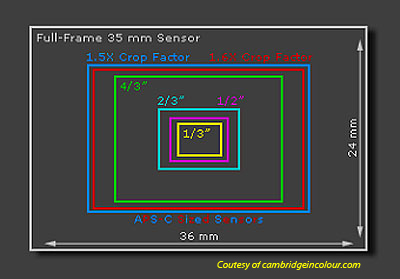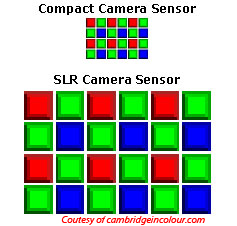The Digital Sensor: A Guide to Understanding Digital Cameras
by Wesley Fink on April 21, 2008 1:00 AM EST- Posted in
- Digital Camera
Sensors Today
| Sensor Size (mm) | ||
| Type | Width | Height |
| 1/3.6" | 4.00 | 3.00 |
| 1/3.2" | 4.54 | 3.42 |
| 1/3" | 4.80 | 3.60 |
| 1/2.7" | 5.37 | 4.03 |
| 1/2.5" | 5.76 | 4.29 |
| 1/2" | 6.40 | 4.80 |
| 1/1.8" | 7.18 | 5.32 |
| 1/1.7" | 7.60 | 5.70 |
| 2/3" | 8.80 | 6.60 |
| 1" | 12.80 | 9.60 |
| 4/3" | 18.00 | 13.50 |
| APS C | 23.70 | 15.70 |
| 35mm film | 36.00 | 24.00 |
In the above chart, the sensor sizes for today's DSLR cameras are in the range of 4/3" and APS C. A few top pro cameras now sport 35mm-size sensors and are referred to as full frame. Comparing this to Compact or Point and Shoot cameras today we generally find a 1/2.3" to 1/2.5" sensor. A few top-of-the-line compact cameras, like the Canon G9, feature a 1/1.8" to 1/1.7" sensor. To see the difference in the relative size of P&S sensors and DSLR sensors, look at the graphic below.

The very best compact cameras have sensors around the 1/3" to 1/2" range. The APS C to 4/3 sensors of the bulk of today's digital SLR cameras are huge by comparison. The developing push for full-frame at the top of the current DSLR market is a move to a sensor that is a bit more than double the size of today's APS C sensors. The approximate 24mm by 16mm APS C is the same size as the 1/2 frame 35mm championed by Olympus in the film era.
This size actually harkens back to 35mm motion picture film that became the standard on which most of the SLR lens systems are based. 35mm motion picture film contained images of around 24x16mm, and 35mm still film just turned the spool direction and used double the frame size. In fact, some early 35mm still cameras were referred to as "double-frame" cameras.
Why Does Sensor Size Matter?
In some of life's arenas bigger is better, but in computers and electronics we almost always see a trend toward smaller and smaller traces producing chips with higher and higher densities. So the question becomes why is a 10MP DSLR sensor any better than a 10MP Compact or Point and Shoot sensor?
The simple answer is that computer chips are digital devices, made up of transistors that register on and off (1 and 0) states, which are then combined to create the information we crunch in a computer. Digital sensors, on the other hand, are analog devices used to gather light and color information. Every digital camera then has some means to convert this analog sensor data to digital information in its processing path. Devices that communicate on and off do not require the sensitivity of devices that gather and convey more complex data like a digital sensor pixel.

Unlike digital data, all pixels are not created equal. Larger sensors, such as those used in digital SLR cameras, have larger pixels. All things being equal the larger pixels have more light-gathering ability over a given unit of time. This translates into two very important considerations for photography.
First, larger pixels exhibit lower noise than smaller pixels under the same conditions. This improved signal-to-noise ratio means that your 10MP DSLR image will likely produce better, sharper, clearer prints than the smaller 10MP compact (point and shoot) cameras. This improved SNR also means larger sensors produce a wider dynamic range (a greater range between the lightest and darkest elements of the photo).
The second aspect also relates to light gathering ability. Large DSLR sensors have more ability to gather light, which means they generally are more effective over a much wider range of lighting conditions than a compact camera. Many compact cameras are perfectly acceptable at ISO 100 but are very noisy by ISO 400. Most DSLR cameras with their larger sensors produce very acceptable results to ISO 800 or 1600 - ISO options not even available on most compact cameras. Some newer DSLR cameras even offer options of ISO 3200, ISO 6400, or even higher.










72 Comments
View All Comments
Johnmcl7 - Monday, April 21, 2008 - link
I do agree with you there that it is desirable to have deeper depth of field (particularly on macro) but I think the difference is that on an SLR you have the choice - you can shoot wide open and have shallow depth of field or you can stop down (and normally have to use up the ISO advantage) to get depth of field. On a camera with a small sensor you are generally stuck with the deep depth of field whether you want it or not.John
finbarqs - Monday, April 21, 2008 - link
I hope nobody is using F/1.2 when shooting a portrait. Unless you want only a nose to be in focus. With something THAT shallow, you either have to REALLY step back and use distance to your advantage to get what you want in Focus. Professional Wedding photographers will not TOUCH anything above f/5.6 as you don't want to get ONLY the bride in focus while the groom is OOF.People, remember there are multiple factors that affect DOF. Aperture is definitely one of them, distance, and Focal Length.
Obviously you want something very shallow with great bokeh, then you would get close to your subject, open up your aperture, and have a telephoto focal length.
The thing is, on a FF sensor, you "see more" on the same focal length as a cropped sensor. Well put wesley, a 50mm is a 50mm. For those of us with cropped sensors, slap a 50mm on your camera. (or zoom to 50mm). Look at your subject with your naked eye, then look through the view finder. SAME SIZE AND SHAPE! Nothing gets larger! Supposedly a telephoto range (greater than normal) should have some zoom effets shouldn't it? I mean APS-C sensors are either 1.5 or 1.6 smaller than a full frame, that means the normal focal length should be around 27mm? So 50mm should be 75mm for nikons and 80mm for canons! That means you should see some zoom in 50mm! but nope! you don't! in fact, the only time you'll see the zoom is AFTER you fire the shutter and it displays the image to fill that 2.5" or 3.0" inch lcd you have! (or even 2.0") So where does the FF excel? you place 2 cameras exactly side by side of each other, same focal length, same focus point. Same lens. Through the Viewfinder, you'll see the nice Bokeh of your subject on BOTH cameras, exactly the same. Difference? the FF has more frame coverage! Thus, having better "DOF" (or lack thereof) because of the more frame coverage! On this note, let's all by Hasselblad's Medium FF and get some nice digital backs! ;)
haplo602 - Tuesday, April 22, 2008 - link
Hmm ... In my understanding the difference in FF to APS-C is CROP.A 50mm lens on APS-C has the same DOF, same perspective characteristic as on a FF camera, but the sensor is smaller, so you basicaly get a CROP of the original FF image. There is only a perceived zoom effect as the image is a smaller area.
For Nikon you get 1.5x smaller image area, but everything else is the same as on FF.
melgross - Tuesday, April 22, 2008 - link
It has to do with distance from the subject as well. Perspective is the ratio of the distance to the subject to the distance to the background.So, to get the same size on sensor, with the same lens length, you must either move closer, or further, changing the perspective, and the depth of field.
finbarqs - Monday, April 21, 2008 - link
Medium Format* sorry, typo :)Johnmcl7 - Monday, April 21, 2008 - link
Other way round - a larger sensor gives you *less* depth of field which as you quite rightly point out is a strong advantage of a larger sensor.John
pinto4402 - Monday, April 21, 2008 - link
DOF is also a function of the lens. Some ultra-serious photographers are willing to pay $2500 for a Canon 85mm 1.2L over a 85mm 1.8 (which is just as sharp and which only retails for $300), because the 1.2L has a softer, more pleasing DOF effect.TETRONG - Monday, April 21, 2008 - link
Cool article.Looking to buy a camera pretty soon here.
What do you folks think about the G9?
Is there a particular brand I should favor?
Also, are there any cameras available that do "tricky" stuff, like Infrared, Macro, or that neat effect when cities look miniature? (Can't find an example)
I read an article about a guy a few years back that would setup a scene, then he would walk around selectively lighting certain aspects in trippy ways to make a final composite image.
Anyone know what this is called, or where I can learn more about it?
Much obliged!
strikeback03 - Tuesday, April 22, 2008 - link
Is "fisheye" what you are looking for for the miniature cities?and the selective lighting is often called "Painting with light"
plenty of compact cameras can do OK macro if you can get really close to your subject, but as this is often hard for reasons of lighting and/or scaring off the subject, an SLR with a real macro lens is still beneficial.
pinto4402 - Monday, April 21, 2008 - link
There was an article at http://www.popphoto.com/popularphotographyfeatures...">http://www.popphoto.com/popularphotogra.../4923/th...about infrared photography. It also discusses a company that is modifying certain digital cameras for infrared use.